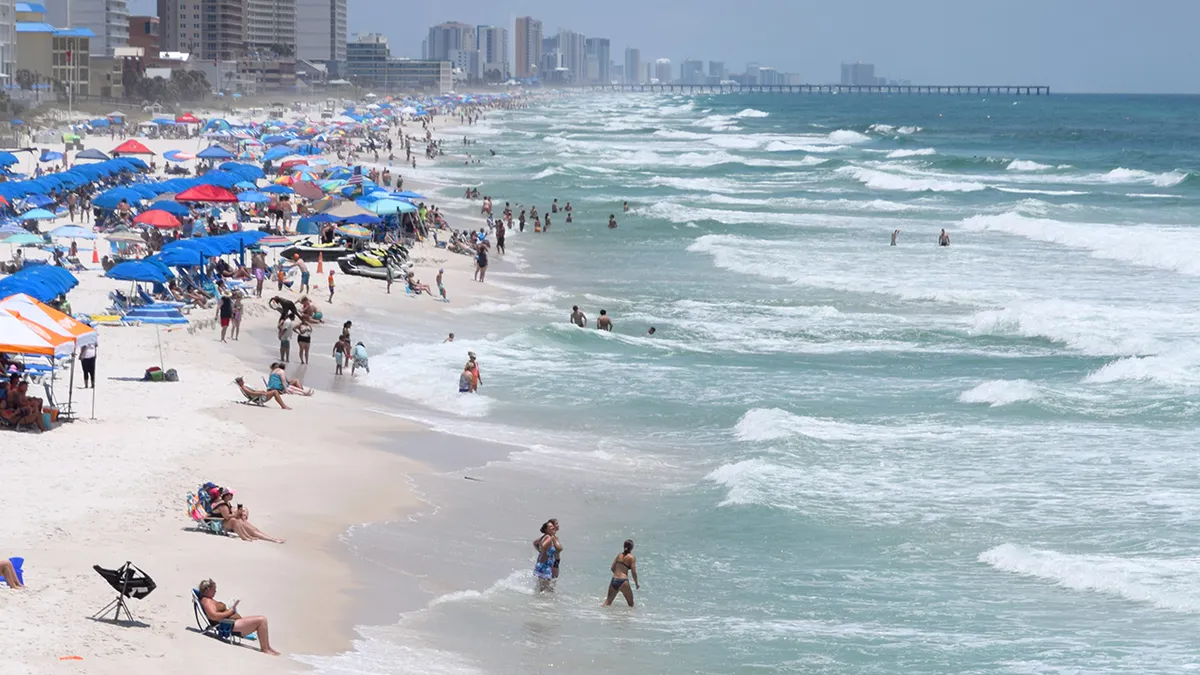Rip Current Formation and Dynamics: Panama City Beach Rip Current

Panama city beach rip current – Rip currents are powerful, narrow channels of fast-moving water that flow away from the shore, often through breaks in the sandbar. They are common along many beaches, including Panama City Beach, and can pose a significant hazard to swimmers.
Panama City Beach’s notorious rip currents have been making headlines lately. These powerful currents can quickly pull even strong swimmers out to sea. For the latest updates on rip current activity and other Panama City Beach news, visit our comprehensive news source here.
Stay informed and safe while enjoying the beautiful beaches of Panama City Beach.
Rip currents are formed by the interaction of waves, tides, and the underwater topography of the beach. When waves break on the beach, they push water up the shore. This water then flows back down the beach in a thin layer called the backwash. If the backwash is strong enough, it can create a rip current.
The treacherous waters of Panama City Beach are notorious for their powerful rip currents, which can swiftly pull even experienced swimmers out to sea. Tragically, these currents have been responsible for numerous drownings, including the recent incident that claimed the life of a young woman.
Panama City Beach drownings are a sobering reminder of the dangers that lurk beneath the inviting waves.
Size, Speed, and Direction of Rip Currents
Rip currents can vary in size, speed, and direction. They are typically 10-100 feet wide and can move at speeds of up to 8 feet per second. Rip currents typically flow away from the shore, but they can also flow parallel to the shore or even back towards the shore.
The deadly currents of Panama City Beach have claimed another life, as an Alabama man tragically drowned while swimming in the Gulf of Mexico. Click here for the full story. The treacherous rip currents that plague these waters pose a constant threat to unsuspecting swimmers, a reminder of the unforgiving power of nature.
Mechanisms Driving Rip Currents, Panama city beach rip current
Rip currents are driven by the interaction of waves, tides, and the underwater topography of the beach. Waves breaking on the beach create a longshore current, which is a current that flows parallel to the shore. The longshore current can then interact with underwater sandbars or other obstacles to create a rip current.
Identifying and Avoiding Rip Currents
Rip currents are powerful, narrow channels of fast-moving water that can pull swimmers out to sea. They can be difficult to spot, but there are some telltale signs that can help you identify them.
Visual Cues
- Choppy water
- Foam lines
- Breaks in the wave pattern
If you see any of these signs, it’s best to avoid swimming in that area. Rip currents can move very quickly, and even strong swimmers can be pulled out to sea.
Dangers of Rip Currents
Rip currents can be very dangerous. They can pull swimmers out to sea, where they can be drowned or injured by waves. Even if you’re a strong swimmer, it’s important to be aware of the dangers of rip currents and to avoid swimming in areas where they are present.
Staying Safe in the Presence of Rip Currents
If you find yourself caught in a rip current, don’t panic. Stay calm and try to swim parallel to the shore. Do not try to swim directly back to shore, as this will only tire you out. Once you’re out of the rip current, swim back to shore at an angle.
If you’re not a strong swimmer, or if you’re caught in a strong rip current, call for help. A lifeguard or other trained professional will be able to help you get out of the rip current safely.
Rip Current Rescue and Management

Rip current rescue and management involve a combination of self-rescue techniques, assistance from others, and proactive measures implemented by lifeguards and emergency responders. Understanding these aspects is crucial for minimizing the risks associated with rip currents and ensuring the safety of beachgoers.
Self-Rescue Techniques
- Stay Calm: Panicking can worsen the situation. Remain composed and focus on executing the following steps.
- Swim Parallel to Shore: Do not attempt to swim directly back to shore against the current. Instead, swim parallel to the shoreline until you escape the rip current’s pull.
- Float or Tread Water: If unable to swim parallel, float or tread water to conserve energy. Do not fight the current; it will eventually weaken.
- Signal for Help: Raise your arm and wave vigorously to attract attention from lifeguards or other beachgoers.
Assistance from Others
- Reach, Throw, Row, Go: If someone is caught in a rip current, follow the “Reach, Throw, Row, Go” protocol. Reach out with a flotation device or extend an object like a towel or rope. If that fails, throw a flotation device. If rowing is possible, use a kayak or paddleboard to reach the victim. As a last resort, go into the water yourself, but only if you are a strong swimmer.
- Assist with Flotation: If you are assisting someone, provide them with a flotation device to help them stay afloat.
- Call for Emergency Help: Contact lifeguards or emergency responders immediately to report the incident.
Lifeguards and Emergency Responders
Lifeguards play a vital role in rip current management. They monitor beach conditions, identify potential rip currents, and provide assistance to swimmers in distress. Emergency responders, such as paramedics and firefighters, are also trained to respond to rip current incidents and provide medical attention if necessary.
Rip Current Mitigation Measures
Various structural measures can be implemented to mitigate rip currents, including:
- Jetties: Long, narrow structures built perpendicular to the shoreline that disrupt wave patterns and reduce rip current formation.
- Groins: Shorter structures built parallel to the shoreline that help trap sand and create wider beaches, reducing rip current frequency.
- Artificial Reefs: Underwater structures that break up waves and dissipate their energy, making rip currents less likely to form.
The effectiveness of these measures depends on factors such as beach morphology, wave conditions, and sediment transport patterns. Careful planning and engineering are essential to ensure their optimal performance.
The treacherous waters of Panama City Beach can pose a significant risk due to strong rip currents. However, amidst the potential danger, the vibrant Panama City Beach flag serves as a beacon of awareness, warning beachgoers of the changing conditions.
Despite the flag’s warnings, the allure of the ocean’s embrace often draws swimmers into the unforgiving grip of the rip currents, a reminder of the ever-present threat that lurks beneath the waves.
Panama City Beach’s alluring shores are marred by the treacherous presence of rip currents, posing a constant threat to unsuspecting swimmers. These powerful currents have been known to sweep swimmers away from safety, leading to tragic disappearances. As the search for missing beachgoers continues, the grim reality of Panama City Beach’s missing casts a shadow over the once-festive atmosphere, reminding us of the dangers that lurk beneath the shimmering waters.